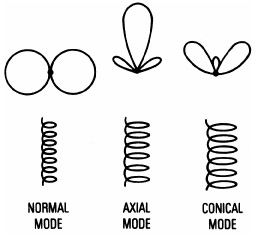Antenna Engineering Handbook, Fourth Edition

Howard E. King
Jimmy L. Wong
The Aerospace Corporation with additions by
Edward H. Newman
The Ohio State University
Helical antennas consist of a single conductor or multiple conductors wound into a helical shape. Although a helix can radiate in many modes, the axial mode and the normal mode are the ones of general interest. The axial mode, the most commonly used mode, provides maximum radiation along the helix axis, which occurs when the helix circumference is of the order of one wavelength. The normal mode, which yields radiation broadside to the helix axis, occurs when the helix diameter is small with respect to a wavelength. Higher-order-radiation modes are also possible; for example when the helix dimensions exceed those required for the axial mode, a conical or multilobed pattern will result, as illustrated in Figure 12-1.

The basic concepts of a helix antenna were established by Kraus1 ,2 in 1947, and much of Kraus's early results were summarized by Harris.3 Generally, helical antennas are wound with a single conduction. However, a helix can be designed with bifilar,4 quadrifilar,5 ,6 or multifilar7 windings. Radiation characteristics of bifilar helices operating in the backfire mode have been described by Patton.8 An advantage of a backfire helix is that it does not generally require a ground plane.
The helix-antenna parameters are defined as follows (see Figure 12-2):
D = diameter of helix (center to center)
C = circumference of...
